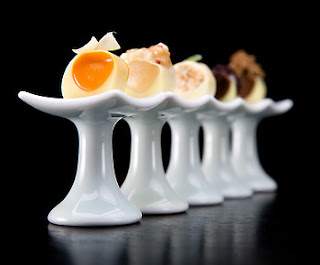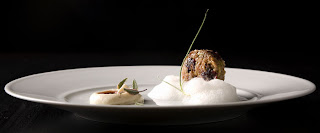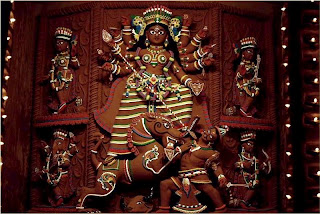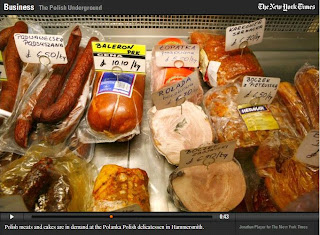 During childhood days in Mysore, I rarely ate out. Food was always freshly cooked at home and served hot. While lunch consisted of rice with meat or fish curry, dinner almost always consisted of chapatis that were served with dal and subzi (vegetable dishes). On special occasions, we would have pooris or parathas.
During childhood days in Mysore, I rarely ate out. Food was always freshly cooked at home and served hot. While lunch consisted of rice with meat or fish curry, dinner almost always consisted of chapatis that were served with dal and subzi (vegetable dishes). On special occasions, we would have pooris or parathas.
On those very rare occasions when we did eat out, it would be dosas at the popular Dasaprakash hotel.
 Chapatis are the most popular Indian bread made at home, followed by parathas and pooris. Chapatis (also called roti or phulka) make no use of oil, unlike prarathas and pooris. Note: Picture of Naan by mind2mind2mind, and Chapati by Aaplemint.
Chapatis are the most popular Indian bread made at home, followed by parathas and pooris. Chapatis (also called roti or phulka) make no use of oil, unlike prarathas and pooris. Note: Picture of Naan by mind2mind2mind, and Chapati by Aaplemint.
Rice has been the staple for those who lived in the Coastal regions of India, while North Indians traditionally ate wheat-based breads. Now-a-days people tend to eat a little of both at home.
 It was only when I began travelling and eating out that I realized there were an infinite variety of breads waiting to be discovered in India. Saturdays in Allahabad were special: almost always a movie with friends followed by dinner at the Civil Lines area. That's where I first tasted Chole Bhature. Made from refined flour like pooris, but more chewy and with a slight sour taste, they were awesome with the delicious chickpeas-based chole served with onion rings and fesh mint chutney. And very popular as one could see by the crowds waiting to be seated.
It was only when I began travelling and eating out that I realized there were an infinite variety of breads waiting to be discovered in India. Saturdays in Allahabad were special: almost always a movie with friends followed by dinner at the Civil Lines area. That's where I first tasted Chole Bhature. Made from refined flour like pooris, but more chewy and with a slight sour taste, they were awesome with the delicious chickpeas-based chole served with onion rings and fesh mint chutney. And very popular as one could see by the crowds waiting to be seated.
 In Dehradun, I would walk down to the Paltan Bazaar shopping area in cold winter evenings for some culinary indulgence. I discovered another new Indian bread here, the Missi Roti, made with besan. Oh what a delight it was polishing off curried eggs and paneer-matar on those foggy evenings.
In Dehradun, I would walk down to the Paltan Bazaar shopping area in cold winter evenings for some culinary indulgence. I discovered another new Indian bread here, the Missi Roti, made with besan. Oh what a delight it was polishing off curried eggs and paneer-matar on those foggy evenings.
Naans, Tandoori Rotis, Missi Rotis, Roomali Rotis, Laccha Parathas...I loved them all and knew where to find the best in the winding gullis of Lucknow. Usually always with a bowl of dal and kababs! And of course, Makke Ki Roti and Sarson Ka Saag (bread made of corn-flour with mustard greens usually served with a dollop of home-made butter) which is a speciality of Punjab during the winter months.
 I was now pretty certain I had gone through the gamut of Indian breads. Until I discovered the Taftan and the Sheermal. Unless you visit Kashmir, these breads are difficult to find in most parts of India. However, if you are in Delhi, I recommend The Great Kabab Factory at the Radission for a taste of these exotic Indian breads along with some mouth-watering kababs.
I was now pretty certain I had gone through the gamut of Indian breads. Until I discovered the Taftan and the Sheermal. Unless you visit Kashmir, these breads are difficult to find in most parts of India. However, if you are in Delhi, I recommend The Great Kabab Factory at the Radission for a taste of these exotic Indian breads along with some mouth-watering kababs.
And finally in Pune I had my first Appam and Neer Dosas which are quite the staple in Konkan restaurants. An appam is just perfect to polish off spicy gassi, a hot-and-spicy gravy made with different meats (chicken, fish or prawns). Neer Dosas are very different from the regular dosas; there are very thin, very moist, and they melt in your mouth.
 Note: Pictures of Chole Bhature by Mayank Agrawal, Poori by Mad Tea Party, Mooli Parathas by Holy Jalapeno, Appam by Claire Forster and smruthy, Kachori by Sunday Night Dinner, Bhakri by evolvingcolor, Sheermal by richdrogpa, and Taftan by Zak.
Note: Pictures of Chole Bhature by Mayank Agrawal, Poori by Mad Tea Party, Mooli Parathas by Holy Jalapeno, Appam by Claire Forster and smruthy, Kachori by Sunday Night Dinner, Bhakri by evolvingcolor, Sheermal by richdrogpa, and Taftan by Zak.
But there is so much more to Indian breads. Here are excerpts form the Hindu BusinessLine last year:
You've heard of plebeian Indian breads like the roti, naan and kulcha, of course. But ever sunk your teeth into the spectacular Agra Ka Paratha? This leviathan of a bread is left to sizzle on a 40-kg griddle till it turns a flaky gossamer gold, making the air redolent with its delicious aroma.
 Then there's Nawab Wajid Ali's spectacular multi-tiered Jalebi Paratha with its secret 200-year-old recipe! The Lifafa Paratha — shaped like an envelope with a pocket — is famous in Amritsar, while the pistachio-flecked Gauzban from Awadh — resembling a cow's tongue — is another epicurean delight.
Then there's Nawab Wajid Ali's spectacular multi-tiered Jalebi Paratha with its secret 200-year-old recipe! The Lifafa Paratha — shaped like an envelope with a pocket — is famous in Amritsar, while the pistachio-flecked Gauzban from Awadh — resembling a cow's tongue — is another epicurean delight.
Not to mention the 10-kg Halwa Paratha, which travels with the Nauchandi Mela across Uttar Pradesh and is served with halwa as an accompaniment.
"Indian cuisine is as diverse as its people and geography," says Radisson's Chef Arun Tyagi, who travelled and researched for the festival for three months. "We have been tracing the culinary journey of the humble bread from Hyderabad (with its linkage to West Asia) to the Vijayanagar Empire and its roots in the Telangana, the mighty Mughals and the aristocratic Nawabs of Avadh to the legendary kitchen of Punjab."
 "When I was travelling across Banaras, for instance, I came across a street called `Kachori ki Gali'! Now how many Indians know that such a street exists in our country?"
"When I was travelling across Banaras, for instance, I came across a street called `Kachori ki Gali'! Now how many Indians know that such a street exists in our country?"
Being a multi-faceted country — textured with a variety of colours, cultures, festivals and languages — Tyagi feels Indian breads too possess an astounding multi-dimensionality. But interestingly, while the recipes of Indian curries — Mughlai, Awadhi, and even Rajasthani — have been documented, the breads' recipes have been passed down purely by word of mouth. And hence, the shroud of mystery that envelopes their provenance. In an evening drenched with culinary history, and plenty of food for thought, we partook of some amazing Indian breads with accompaniments like the flavour-charged murgh kalimirch tikka, the melt-in-the-mouth dorra kebabs, machli ajwaini and kofta naram dil.
Other exotic Indian breads worth a mention:
 Lal Roti: A Delhi speciality, this bread gets its name from its reddish-brown hue. A sweet, leavened bread, lal roti is also referred to as the sheermal, as it is akin to the bread of the same moniker available in Lucknow and Mehmoodabad.
Lal Roti: A Delhi speciality, this bread gets its name from its reddish-brown hue. A sweet, leavened bread, lal roti is also referred to as the sheermal, as it is akin to the bread of the same moniker available in Lucknow and Mehmoodabad.
Agra ka Paratha: The Agra ka Paratha is rarely known outside of Agra. Made in dome-shaped, gargantuan griddles, the bread was presumably discovered by Rambabu of Agra. It uses a gram-wheat-flour combo with a variety of fillings to give it a unique taste. Rambabu Paratha Bhandar in Agra, set up almost a century ago, continues to delight customers with this wonderful bread and even exports it.
Kachori: Banares is renowned for its jalebis and kachoris. The Kachori ki Gali here produces some of the most scrumptious kachoris in the world. Fennel and dhal-flavoured, potato-stuffed or paneer-filled, the result is pure manna.
Double Puri: A unique bread made in Amritsar, this is a double-tiered puri, a wonderful innovation by the city's Kanha restaurant. It is said that such huge crowds throng this eatery for breakfast every morning that in two hours flat the kitchen empties out its produce and shuts shop!
 Bhakri: Maharashtrian cuisine has some wonderful influences from south and central India. One of the most wonderful dishes of Maharashtra is the Bakri-keema from Kolhapur. A bread made from millet, the bakri teams wonderfully well with the fiery Kolhapuri keema. Update: Check this post for the recipe of the bhakri-pthale sandwich shown alongside.
Bhakri: Maharashtrian cuisine has some wonderful influences from south and central India. One of the most wonderful dishes of Maharashtra is the Bakri-keema from Kolhapur. A bread made from millet, the bakri teams wonderfully well with the fiery Kolhapuri keema. Update: Check this post for the recipe of the bhakri-pthale sandwich shown alongside.
Pathri: This exquisite bread from the Mopla community of Kerala is made of rice flour, rolled out like a phulka and smeared with coconut milk and saunf before serving. The sweetness of the coconut milk and fennel give it a wonderful taste.
Mawa Kachori: It is a tradition in Jodhpur that you begin each meal with a sweetmeat. You can't escape from the city's sweet hospitality or Mithi Manuhar as it's called. Mave ki Kachori, Besan ki Chaaki and Maakhan Vade are some of Jodhpur's renowned sweet bread offerings.
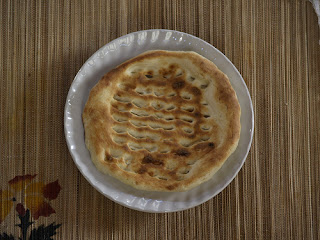 Chowringhee Mughalai Paratha: The Mughalai Paratha, sold on Kolkata's Chowringhee Road, has imbibed influences from North India. A bread made of refined flour that is dipped in egg and fried, this paratha is a meal in itself and is sold at special roadside eateries.
Chowringhee Mughalai Paratha: The Mughalai Paratha, sold on Kolkata's Chowringhee Road, has imbibed influences from North India. A bread made of refined flour that is dipped in egg and fried, this paratha is a meal in itself and is sold at special roadside eateries.
Mandwa Ki Roti: Mandwa is a grain grown in the Himalayan regions of Garhwal, Himachal Pradesh, and Nepal. This plant requires no water to grow and does not get infected for years. A heat-generating grain, its rotis are ideal for the hilly regions and is eaten after being smeared with ghee and sugar.
Gauhat ka Paratha: Gauhat, a lentil grown in the mountains of Garhwal, is boiled and mixed with chopped onions, coriander and green chillies. This concoction is then stuffed in a Mandwa-flour dough, rolled out and cooked slowly on a tawa.
 And finally Kashmir where you can try breads such as Sheermal and Baqerkhani, without which no Kashmiri breakfast is complete. Kashmiris use a variety of breads seldom seen elsewhere. Tsot and tsochvoru are small round breads, topped with poppy and sesame seeds and traditionally washed down with salt tea. Lavas is a cream coloured unleavened bread; baqerkhani is the Kashmiri equivalent of rough puff pastry and kulcha is a melt-in-the mouth variety of short-bread, sweet or savoury, topped with poppy seeds.
And finally Kashmir where you can try breads such as Sheermal and Baqerkhani, without which no Kashmiri breakfast is complete. Kashmiris use a variety of breads seldom seen elsewhere. Tsot and tsochvoru are small round breads, topped with poppy and sesame seeds and traditionally washed down with salt tea. Lavas is a cream coloured unleavened bread; baqerkhani is the Kashmiri equivalent of rough puff pastry and kulcha is a melt-in-the mouth variety of short-bread, sweet or savoury, topped with poppy seeds.
And so, dear readers, if you thought only the French have variety in their bread, think again! :-)
If you liked this, you may also enjoy the following posts:
Read More...
 At the press conference, Michelin also crowned 82-year-old Jiro Ono of Sukiyabashi Jiro sushi restaurant in central Tokyo the world's oldest three-star chef.
At the press conference, Michelin also crowned 82-year-old Jiro Ono of Sukiyabashi Jiro sushi restaurant in central Tokyo the world's oldest three-star chef.













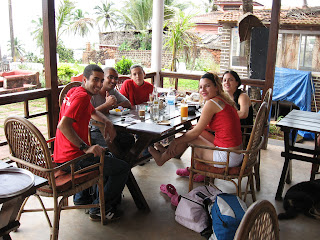

 Before we were able to pay attention to food, Americans had to perfect democracy, settle the West, free the slaves, crush the Nazis, and fight the commies. Meanwhile, we ate whatever was at hand. We stewed squirrels. We turned turtles into soup. Food was secondary. Oh, we had raw materials aplenty: fields of waving grain, herds of juicy protein, oceans of non-farmed fish. We just didn't know what to do with it all.
Before we were able to pay attention to food, Americans had to perfect democracy, settle the West, free the slaves, crush the Nazis, and fight the commies. Meanwhile, we ate whatever was at hand. We stewed squirrels. We turned turtles into soup. Food was secondary. Oh, we had raw materials aplenty: fields of waving grain, herds of juicy protein, oceans of non-farmed fish. We just didn't know what to do with it all. 





